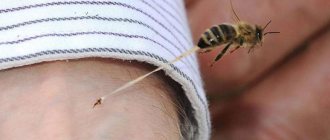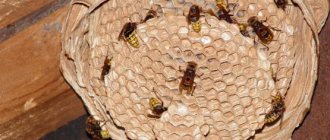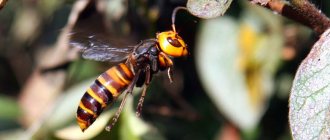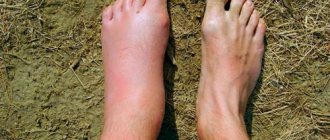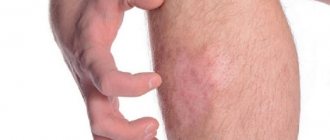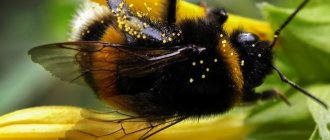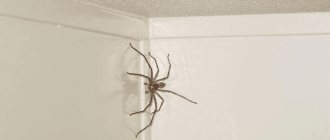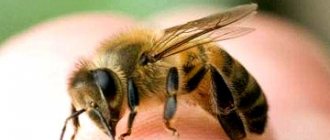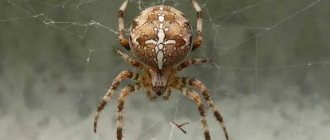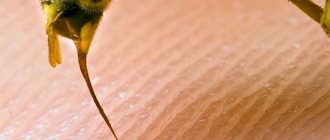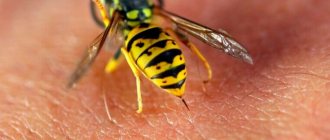Lifestyle of hornet and wasp. Appearance of insects - size, body anatomy, sting. Danger of poison to humans. Construction of a wasp and hornet nest. Symptoms that accompany the bite. Health care. Allergy to the bite.
Hymenoptera are a large order of insects that include many species and genera. People often confuse them with each other, so you need to figure out how a hornet and a wasp differ, understand their appearance, danger, lifestyle and reproduction. Knowing the details, you can protect yourself from stinging hymenoptera.
Main differences
Entomologists have devoted many years to studying these types of insects, so now you can easily understand the differences between wasps, hornets, and bumblebees. The first, and most important, difference is the size. The hornet is the largest when compared with all social wasps - a subfamily group that uses paper during construction.
But size is not the only difference. It is also worth mentioning the difference in pigmentation. An ordinary wasp is characterized by a classic yellow color, while a hornet is darker, most often brown. There are also differences in the caliber of the tip. Despite the fact that hornets are not the largest representatives of Hymenoptera, they do not use their stings as often as wasps, since they are less aggressive in nature.
How are they different from a bumblebee?
People without zoological education confuse hornets not only with wasps, but also with bumblebees. They do not understand how a hornet differs from a bumblebee.
Entomologists highlight the following points::
- Hornets are close to wasps, and bumblebees are close to the honey bee.
- Bumblebees are quite large (the female is 1.3-2.8 cm, and the male is 0.7-2.4 cm), but hornets are larger than them.
- Bumblebees are usually yellow and black, often striped. In addition, there are bumblebee species with red or orange stripes, and some species are solid black. In addition, their body is furry.
- Bumblebees and hornets are social insects. But both species go out in search of food alone. Bumblebees try to collect nectar before other Hymenoptera, which are still in the sleep stage.
Compared to hornets, bumblebees are less prone to conflict. Having understood how each representative of the Hymenoptera differs, a person will be able to clearly understand who is in front of him. This will help them act correctly to avoid being stung.
Lifestyle
The hornet and the wasp are social insect species. Socialized Hymenoptera increases the population through the laying of eggs by the queen, which can reproduce more than two thousand workers in one fertilization. They are busy building nests. The activity of members of the family depends on the time of year.
When it comes to what differentiates wasps from bees, they do not produce honey, and their feeding method differs depending on the species.
Wasp diet:
- In the summer, they consume flower nectar, bee honey, fruit juice, vegetables, and berries. Sweets and rotten foods are also considered delicacies;
- They are greedy for kvass, lemonades, fruit and vegetable juices, jams, syrups;
- Often, predators attack a bee family, destroying the hives in just 2 hours. They consume the honey themselves, and take the bees to feed the larvae.
Hornets hunt smaller representatives of insects - wasps, flies, caterpillars.
Stings
The bee's sting is disposable if it bites a person. Due to the presence of notches, it is not able to pull it out of human skin. After being stung, the bee dies, but if it stings some other creature, it can survive. A bee can be aggressive if it swings its arms too much.
As for wasps and bumblebees, they have multiple-use stings and can bite a person more than once. At the same time, a wasp can bite just like that if it doesn’t like something. The most harmless creature in this regard is the bumblebee. To make him bite, you need to try very hard.
Differences in appearance, photos
In appearance, the insects are quite similar, but differ in size. The queen hornet reaches a length of about 4-5 centimeters, the working individual and the male are slightly shorter. Common wasps are on average comparable to other Hymenoptera species. The working individual reaches 1.2–1.4 centimeters in length, the female – 1.8 centimeters.
In addition, it is necessary to say about the differences in color and other features. Small wasps do not have a shade of brown on their bodies - their colors are predominantly yellow and black. Large relatives are characterized by the presence of a brown tint, most often in the cephalothorax area.
The two representatives are distinguished by their characteristic thin waist, powerful jaws and large visual organs, but there are differences in the size and shape of the head. The hornet has an almost round shape and a wide nape, the wasp is small in size and has a narrowed shape near the base.
Features of the life of hornets
Hornets are social insects, so they can unite when attacking a victim.
The nests have a strict hierarchical system, with queens dominating hornet hives and being the only females capable of reproducing. Queens lay eggs. Most other hornets are asexual workers who perform important social duties such as building the hive, collecting food, feeding the young, and defending the colony.
There are few males and they have only one role - mating with the queen. Males usually die soon after completing their sexual task.
In colder climates, hornet nests are abandoned in winter; young queens and their eggs survive by finding sheltered areas under tree bark or homes.
In the spring, such a queen will lay a new nest, and soon her young will become workers and take over the duties of the new hive, leaving the queen to breed.
She will produce more workers to expand the hive and before she dies, she will produce a breeding generation of new queens and males (drones) to start everything over again.
Nest construction
The presented insects construct similar hives. The main difference is the color. The wasp family builds gray cocoons, while the hornet family builds brownish ones. Rotten wood and birch bark are used as construction materials.
The housing structure of the Hymenoptera is characterized by its multi-tier structure and oval shape. The population size is affected by the size of the hive. Regarding the location of the nest, it is impossible to distinguish wasps from hornets, since one prefers the same locations - old cavities in tree trunks, bird nests, the roof and attic of a human house.
Reaction to a hornet sting
If someone is stung multiple times or has a severe allergy to insect venom, systemic reactions may occur that can affect the entire body. Typical symptoms and reactions to bites:
- Strong pain
- Redness
- Swelling around the bite site
If a person is allergic:
- Nausea, vomiting
- Cold extremities
- Blue discoloration of the neck, eyelids, face, ears
- Attacks of suffocation
- Swelling of soft tissues
- Red spots on the body
- Loss of consciousness
Vespiary
Wasps independently obtain building material. It is an old stump, a tree, a fence, various buildings made of wood - this affects the gray tint of the hive. When a suitable material is found, the insect begins to moisten it with its own saliva, after which it scrapes off the thin wood fibers. Powerful jaws are used to collect a sufficient amount of building material.
Having made preliminary preparations, the stingers go to the place where the construction of the cocoon is planned. Next, the lumps are once again processed using the jaws and generously moistened with sticky secretion. Afterwards, the process of forming the cells of the hive begins - strips of material are rolled out perpendicularly, as a result - the formation of a thin paper cell wall, over time a complete housing is obtained.
Interesting Facts
These insects are interesting because they:
- Bees, after fertilizing the queen with males, attack them and expel them from the family. After this, they quickly die, as they cannot provide themselves with food.
- Wasps can also make honey, but no one has seen it. The microscopic volume of honey is located at the bottom of the cell. It is necessary so that the larvae have something to eat at first. After this, they switch to eating protein foods.
- Bumblebees appear on the inflorescences earlier than anyone else and begin to pollinate plants before anyone else.
- The hornet is a true predator that prefers to feed on live insects.
- A worker bee can transmit information to its relatives about where the food item is located.
Each insect has its pros and cons. Unfortunately, many people unjustifiably destroy insects, although absolutely useless living creatures do not exist in nature. If some species disappear, humanity simply will not be able to survive.
Hornet's nest
Hornet also has excellent construction skills. They form their nest using rotten wood, which is first chewed and moistened with saliva. The resulting building material is used to create honeycombs and the frame of the hive; saliva is used as glue. The dried frame is similar in appearance to corrugated paper. The shade is usually brown, but can vary as different types of wood are used.
This large stinger will never use its nest next year. After wintering, the queen looks for a comfortable place to start building a new home. A “leg” is attached to the base, to which the first honeycomb cells are attached.
Cocoons grow from top to bottom. The number of tiers gradually increases, as well as the formation of a multilayer shell. Depending on the number of layers laid, one can guess the size of the population living in this hive. The design is characterized by a shell of up to 8 centimeters, thanks to which the larvae are protected from summer heat, sudden temperature changes and strong winds.
Popular topics today
- Chanterelle mushroom
The common chanterelle mushroom is used as human food. Belongs to the Chanterelle family. He got his name from the Russian word - Palace of the Caliph
One of the largest mounds north of Jericho is the palace of Caliph Hisham. At the time the palace was discovered, large-scale excavations were very difficult to carry out, from 1934 to 1948. - Constellation Pisces
One group of stars has been known to mankind for more than two thousand years. This is the constellation Pisces. Location on the star map It is inconspicuous in the starry sky, - Echinoderms
Echinoderms are very peculiar animals. The appearance is not similar to anything at all. From the outside you might think it is a flower or a starfish. They received this name from the ancient Greeks. - Rules of the game of volleyball
The game itself is one of the sports that is played only as part of a team using a ball. The object of the game is to hit the ball with your upper body. - Tchaikovsky
Pyotr Ilyich Tchaikovsky is a great Russian composer and conductor. His work contributed to the rise and development of culture both in Russia and in the world.
Human interaction
Many people have encountered wasp bites - this is a rather aggressive insect that attacks almost immediately if they sense a dangerous situation. The hornet is less aggressive towards people, but will attack if there is danger for itself, family or nest.
Lesser Hymenoptera often flies into human possession because they are attracted to food supplies. They easily enter residential buildings and apartments through an open window, but will bite if threatened.
Attacks by a whole swarm are very dangerous for people. A wasp can sting up to three times in a minute, sticking its sting under the skin of a person, they inject poison. If a large amount of a toxic substance enters the bloodstream at the same time, the human body can react unpredictably, the consequences will be especially severe for allergy sufferers.
If we talk about hornet behavior, it is influenced by taste preferences. They prefer sweet foods - honey, sugar, fruits, berries. But relative to humans, they are not so aggressive. An attack is carried out only if there is a presentiment of real danger. To feed the larvae, they catch insects, caterpillars, and spiders.
Comparing the bites of two stinging ones, the second ones sting not so painfully, but there is still a risk of an allergic reaction with difficult consequences. The victim experiences swelling, hyperemia of the bitten skin, pain, and a local increase in temperature. Allergy sufferers experience nausea, vomiting, general loss of energy and breathing problems.
Hornets description
Hornets belong to the genus Vespa (wasps). Hornets are the largest and most aggressive representatives of the wasp family, the length of the largest species reaches up to 5.5 cm. There are only about 20 species of hornets in the world. Most live in tropical Asia, but the insects are also found in Europe, Africa and North America, where the European hornet was introduced by humans. The venom of some hornets, such as the Asian giant hornet, is extremely dangerous and the sting can be fatal. The hornet is not aggressive and is unlikely to bite unless you attack it or its nest.
What to do if bitten by a stinging insect
Many people do not know what to do if they are bitten by a member of the wasp family. When severe pain occurs, you can understand that the body is undergoing destruction. It is necessary to understand that the poison contains toxins that have a strong effect on the nerve endings, which is why the pain shock is very pronounced.
In normal situations, it is difficult to imagine the consequences of an attack because everyone reacts differently. Some may get by with only pain and swelling, while others may face dire consequences, including asphyxia, loss of consciousness, and even death.
It is very important not to hesitate and immediately provide first aid:
- Remember the main rule - there will be no sting in the wound, only poison, so there is no need to look for it and try to squeeze it out.
- Try to remove the toxic substance by sucking it out.
- Treat the affected area of the skin with citric or acetic acid.
- Try washing the wound with soapy water.
- Treat the wound with a solution that contains alcohol; you can also use hydrogen peroxide.
- Apply something cold and wet sugar to the wound - this will reduce the rate at which toxins spread through the blood.
- Do not drink alcohol if you are bitten - this will increase swelling and worsen the general condition of the victim. Attacks to the neck and head area are especially dangerous.
- If you take into account folk remedies, you can use dandelion juice, plantain juice, and soda solution. A slice of onion and garlic works great.
Symptoms of an allergic reaction are accompanied by:
- Severe headache;
- Increased body temperature;
- Rapid heartbeat;
- Heavy breathing;
- Abdominal pain.
If the above induced symptoms occur, the victim should take a pain reliever tablet to reduce the effects of histamine. You should also drink plenty of water to reduce poisoning.
Remember that if there is no improvement in your condition, consult a doctor immediately.
Harm or benefit of hornets
Hornets are often considered pests, especially when they nest near people, because... they will aggressively defend their nest if they feel it is in danger.
Hornets are quite dangerous insects, for example the Asian giant hornet is considered the most dangerous arthropod on the planet. When in danger, the insect releases a special “smell” that attracts other hornets. Hornets can attack humans due to the characteristics of perfume.
Hornets cause particular harm to beekeepers, destroying all the bees in the apiary.
One hornet can destroy up to 10 bees. When one hornet finds a bee colony, it leaves a special scent that attracts other hornets. (There is an opinion that hornets destroy only sick bees, although this fact has not been proven.)) There are cases when bees defeat a lone hornet in a battle, surrounding it.
Hornets whose nests have been destroyed or poisoned are considered especially dangerous. In some countries, it is prohibited to destroy hornets; they are believed to be beneficial for the ecosystem.
Lifestyle and behavior
The difference between insects is visible even in flight.
The bees fly calmly, slowly. Wasps - hastily, intermittently, suddenly stop, freeze.
Hornets fly more calmly. The flight of bumblebees is heavy, leisurely, with a low hum.
Insects live in different ways.
Bee
Bees create families where they adhere to strict subordination.
Domestic insects live in hives built for bee colonies by the beekeeper.
For wild bees, tree hollows and rock crevices are places where you can build a house.
The queen bee is surrounded by attention and care from other residents of the hive; no one cares for the wasp queen, she is left to herself. Bee house. Bee house
Bee house
Solitary bees are less common. They live in burrows in the ground, sometimes the thick stems of individual plants and tree crowns serve as their home.
The inner walls of the bees' home are treated with wax (a thin layer). Nectar and pollen are also carried there. The eggs are laid on supplies and the hole is covered with earth. Then they set up a new one.
Bee offspring eat nectar and pollen. The larvae form into a pupa, from which a mature bee grows.
Wasp
Many species of wasps live in disciplined families, where they follow strict obedience: each individual performs its duties.
Wasp nests are not as solid as bee nests, since they are built from chewed grass and rotten wood. Wasps attach their homes to the walls of houses and the eaves of buildings.
First, the queen creates one cell and lays an egg there.
The first one is slowly overgrown with other cells (like honeycombs in beehives). The hatched wasp larvae are fed with rough food (crushed insects, caterpillars). When the larvae eat, they produce saliva. It is collected by mature individuals (tropholaxis process).
As the larva grows and develops, it clogs the cell, forming a cocoon. A mature wasp is selected from it (usually in the last month of summer). But not all larvae mature; some of them die without surviving the winter.
The used cell is cleaned, and again the female lays an egg there.
Vespiary
Hornets have similar nests.
Hermits are often found among wasps. Singles do not arrange homes. Females find food in the ground: beetle larvae, immobilize them and use them as a place to lay eggs.
Bumblebees live in groups of no more than two hundred individuals in each group. They nest in holes left by rodents and are suitable for homes and tree hollows.
Lifestyle
The rules for the existence of hornets in nature are very similar to those of bees and ants.
In order to survive during the cold winter and give birth to offspring every year, insects have to sacrifice someone and something. They sacrifice males, who die soon after mating. This way resources are not wasted on already “useless” individuals. After all, in the hornet family, the females are the main ones. Therefore, they must prepare well for hibernation, survive it, and in the spring become the founder of a new colony. The uterus needs a large amount of protein to produce eggs and develop ovaries. In order to successfully overwinter, it eats very richly and accumulates a fat body.
Mating Features
The greatest activity in the hornet family is observed at the end of the warm period of the year, namely the end of August and the beginning of September. By this period, individuals of both sexes become adults. They all leave their home, swarm and mate. Thus, mating occurs before the onset of cold weather. Female hornets spend the winter pregnant.
Males die soon after mating. Females lead a solitary lifestyle. They feed heavily, and between meals they fly around the nearby territory in search of a safe place for winter shelter. Overwintering of a pregnant female hornet, which falls into suspended animation, is possible only in a secluded place where enemies and cold winds will not find her.
Wintering conditions
Crevices in rocks, tree hollows, shelters under stones and fallen trunks, and small cavities on the outside of unheated buildings or houses are well suited for this. There is no need to be afraid that the female will hide inside a human house. There's a good reason for this. When cold weather sets in, when the air temperature drops below 0C, all water freezes.
But the water in the hornets does not freeze. This is due to the fact that in the body of insects, water is replaced by glycerol. It does not freeze, but it slows down all life processes. This way, the glycerin cannot turn into ice and rupture the insect cells. If the hornet warms up prematurely, it will die during the next cold snap.
When the female hides for the winter in a heated human house, the warm air temperature will contribute to her premature awakening and the natural need to build a nest. If she manages to hide in a house from human eyes, then it will be very difficult for her to look for material to build the honeycomb of her “house”.
When she manages to build a nest, she will not be able to find enough food in the house to feed her offspring. Thus, she will doom him to certain death. Therefore, female hornets do not choose heated human houses for wintering.
A lot of female hornets die during harsh winters with little snow, as well as in the presence of winter thaws. If the female does not manage to hide well, she will become prey to various birds or small predators. Therefore, a significant number of hornets do not survive until spring.
Spring chores
The female hornet wakes up when the air temperature warms up to +15C. Young pregnant insects that wake up begin to actively hunt so that the embryos can develop into full-fledged eggs. In addition, the young female is looking for a suitable place to build her nest.
Help with a bite.
Old females also wake up, but they do not look for a place to build a nest. They scatter around the surrounding area. When the first cold days arrive, they stop their activity and freeze. As a rule, they die before they reach their second wintering. After a nest site has been found, the young female builds the first comb and lays her eggs there.
Only worker hornets emerge from the first eggs. The female must raise them. Then they take the baton into their own hands. Working individuals independently complete the nest and feed the larvae from later eggs. Already from these larvae males and females will grow. They will begin a new cycle in August. The lifespan of worker insects is only three to four weeks.
If you meet a hornet in early spring, it is most likely a pregnant female busy with procreation. She doesn't specifically touch people, but she's not afraid of them either. The female is not dangerous to you. She has no time to threaten anyone, because she has many more important things to do. Don't touch her. Let her reproduce her offspring.
OUR READERS RECOMMEND!
To get rid of insects, our readers recommend the Pest-Reject repeller
. The operation of the device is based on the technology of electromagnetic pulses and ultrasonic waves! Absolutely safe, environmentally friendly product for humans and pets. Read more here...
Where can you find bees?
“It depends on what kind of bee we are talking about. Honeybees like to build hives in hollow trees, while bumblebees will nest in cavities similar to abandoned rodent burrows, Troiano says. “Both of them can be seen on flowers when they are extracting nectar.”
Carpenter bees typically nest in wood, including partially rotted trees. They also like wood with an unpainted surface.
Russian tourists will be allowed into Cyprus without quarantine
The animated series "Peppa Pig" will last until 2027, 104 new episodes will be filmed
How can a woman keep a man? Advice from Mikhail Zadornov (and the main female mistake)
